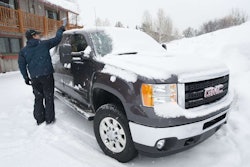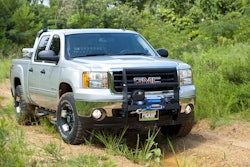 AUXILIARY LIGHTS BUYER’S GUIDE
AUXILIARY LIGHTS BUYER’S GUIDE
By Bruce W. Smith
How to select the best aftermarket lights for your pickups – for both work and play
Most contractors are well into their second cup of coffee and headed to the company office or jobsite before sunrise and headed home after it sets.
Driving when it’s dark is just part of being in the construction and landscaping trade.
So is loading tools, gear and trailers before sunrise or after sunset whether it’s for work-related or recreational.
In short, those who use pickups for both work and play don’t let daylight dictate their plans.
That’s why auxiliary lights are so important.
Not only do these products add more functionality and utility value to whatever it is they are mounted on, they bring an additional level of safety to the picture.
But that doesn’t mean you should blindly rush out to the nearest discount auto parts store and buy the first set of auxiliary lights you lay eyes on.
Choosing which auxiliary lights to install on a pickup used for work, family and weekend recreational purposes entails a few more considerations than slapping on the cheapest box of lights available.
Instead, target specific types of lights that will make things safer and easier as you drive or work around your pickup.
Choosing the “right” auxiliary light upgrades could be as simple as one set of fog lights – or an array of several different types of lights. It all depends on your particular needs.
And if it’s price holding you back from investing in auxiliary lights, consider this: Lights are the one aftermarket accessory that’s easily moved from vehicle to vehicle regardless of make or model. So your initial investment should last for years. 
LIGHT TYPES
Speaking of investment, auxiliary lights tend to be priced in line with the quality of the product and technology.
For example, quartz-halogen lights are less expensive than lights of similar function utilizing LED (Light-Emitting-Diode)- or HID (High-Intensity-Discharge)-based technology.
The price of both LED and HID auxiliary lights is coming down and getting more competitive with the halogen variety, which is great news for pickup owners.
If you aren’t familiar with the LED and HID lights, understanding how they work and what they contribute to a pickup’s utility and driver safety is important in making your purchase decision.
Your run-of-the-mill lights run electricity through a filament surrounded by a gas, such as halogen. As the filament heats up and burns it produces light. But because the heart of the bulb is a wire, it will eventually burn in half or break from vibration.
The light output and efficiency of such lights don’t stack up against that produced by HID or the newest generation of LEDs.
HID-based lights don’t have filaments. Instead, an internal or external ballast builds up the power to create light when an arc jumps between two electrodes, stimulating a special mixture of Xenon gases to produce a brilliant, almost blue-white light that’s about three times brighter than a halogen bulb emits. Think lightning in a bottle. 
The benefit of HID lighting is it has a much longer life expectancy than halogens while being very efficient, requiring about a third less power than conventional bulbs of comparable output.
And the light color is that of sunlight, which makes it easier to see both detail and longer distance compared to conventional halogen lighting.
The downside: Most HIDs are designated for “off-road use” only, and they are usually more expensive compared to lights of similar output/function.
LED TECHNOLOGY
LED auxiliary light technology has really advanced in the last couple years. The prices have come way down, the light output gone way up. They’re also available in all types of functions and configurations tool box lights to fog/work lights and driving lights.
LEDs come in a variety of shapes and sizes, too, from round and rectangular lights to light bars several feet long.
The key to their brightness and light output is the size and number of crystals used, the makeup of the crystals, the design of the epoxy surrounding the crystal, and the lens used to direct the light.
What makes LED lights ideal for pickups used in the construction and off-road environments is they are not prone to death by vibration or the elements.
“Advanced white LED technology offers substantially longer life than comparable incandescent lamps (50,000 hrs. vs. 400 hrs),” says Truck-Lite’s Jamie Lindemuth. “Essentially, this equates to nearly six years of non-stop, continuous use. Given that, the lifespan of Truck-Lite LED products will most likely out-live the vehicle.”
LEDs also require about 85-percent less amperage to power than hologens, saving added wear on batteries and alternators. 
MUST HAVE LIGHTS
Light type and price aside, it’s the function of the lights added to your pickup/trailer package that makes the difference.
Many years of driving in a multitude of weather conditions over vast types of terrains has taught me the typical contractor’s pickup used for work and play needs a minimum of two types of auxiliary lights: fog and driving.
Fog-type lights, with their wide, flat pattern, are worth their weight in gold when the weather turns sour – or you need to see more of the road closer to the front and off to the sides.
Well-designed fog lights throw light out about 100 feet with an even spread across both lanes of a two-lane road as well as a dozen yards off the shoulders.
The good ones also have a distinct cut-off along the top of the light beam that prevents light glaring back in your eyes when thick fog, rain or snow reek havoc on visibility.
When it comes to lens color, amber is hard to beat.
Fog lights also work great in two other applications: as work lights and reverse lights. Their broad light pattern does a superb job illuminating a larger area close to the vehicle such as when winching, working in the bed or loading a trailer.
DRIVING LIGHTS
When it comes to driving, be it paved road or gravel, nothing helps relieve eye-strain better than a good set of driving lights. Driving, or spot-beam lights throw out a tight, well-focused light pattern that can light reflectors up to a mile away in some applications. (Check local/state vehicle laws to make sure they are legal for use.)
Like fog lights, quality and technology make a difference in driving lights. HID driving lights, for example, can reach out hundreds of feet farther than conventional headlights. And there are some dual-pattern driving lights that can be switched between a long-range pencil beam and a mid-range road light.
Driving lights are also where the watt-wars and candlepower sales pitches flourish. Be a smart buyer – don’t fixate on those big numbers (read sidebar, “Watts Better” for an explanation). Rather, concentrate your shopping on 1) lumens-per-watt efficiency; 2) the quality of the housing and mounting system; and 3) the type of beam it projects.
WATTS BETTER
Some manufacturers lead buyers to believe there’re only two terms that matters when it comes to the quality of aftermarket lights: watts and candlepower. Both are very misleading.
Watts is only a measurement of current draw (Volts x Amps= Watts); it’s the automotive equivalent of how many gallons of fuel-per-hour an engine uses – not the miles-per-gallon the engine in the pickup delivers driving down the road.
For example, a 100-watt HID driving light is far more effective lighting up the road than a single 100-watt light bulb sitting on the bumper. The difference is in how the bulb’s light output is focused, which brings up another misleading marketing term: candlepower or candela.
Candlepower (aka candela) is an antiquated measurement of light output at the source (radiance) and has nothing to do with how that light illuminates an object.
Lumens, on the other hand, is a true measurement of a light’s efficiency at lighting up an object at a specified distance and is fast becoming the world standard for light comparisons. The higher the lumens, the more useable light being produced.
So when you find auxiliary lights to fit your needs that consume the same or less power, has similar design qualities, and delivers a higher lumen output than a comparable model, you know which to buy.—BWS
 WIRING KITS
WIRING KITS
The inclusion and quality of the wiring kit supplied with the lights is also important. The better the kit, the less time you waste during installation or making repairs down the road.
Quality light kits provide everything needed to install the lights so they are wired properly.
Look for plug-and-play light kits that include pre-assembled wiring harnesses with relay, switch, and connectors already in place. Cheaper kits may only include the lights, leaving you to figure out the rest.
One thing you don’t want happening is auxiliary lights overloading the pickup’s electrical system; tripped circuit breakers, blown fuses and melted switches are just a tiny step away from a costly electrical fire.
LIGHT POSITION
It’s also prudent to be smart about where you mount auxiliary lights. Mount them where they do the most good, and where possible, run the wiring inside racks and behind bumpers where the wires are protected. Don’t scrimp on the use of split-wire loom, either.
Placing driving lights above the cab looks all Baja-cool, but the high-mount positioning renders them almost worthless in snow, dust, rain or fog because their beams of intense light reflect off the moisture and right back into the your eyes. Keep driving lights at or below the headlights position.
Work lights, on the other hand, function best mounted up high. And if used as reverse lights, mounting them right into the tailgate or rear bumper works well.
Fog lights work best mounted in or on the bumper where their beam can cut just under that of the low-beam headlight’s pattern.
Also be conscientious toward your fellow drivers: Fog lights should be aimed so the beam is no higher than low-beam headlights and angled slightly to the left/right of center.
Driving lights should be aimed to match your pickup headlight’s high-beam and centered down the middle of the road for maximum efficiency.
BUILD QUALITY
You purchase quality work tools that last and you’ve spent a good bit of money on the pickup you’re driving. Do the same when you buy lights.
Leave the cheap plastic and pot-metal models to those who don’t depend on their pickups as part of their daily work needs.
Strong housings that will not rust or come apart under tough conditions are a must. So are lights with wiring kits made from heavy-duty components.
Check out the light’s warranty, too: The longer the warranty, the better the product.
Now that we’ve shed a little light on the topic of auxiliary lighting, we’ve included an assortment of the newest products to consider adding to your pickup – or fleet of pickups. Mix, match and enjoy the new view. (Click here to see the newest in auxiliary lights.) –Pro







